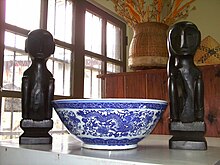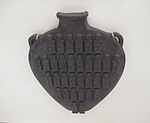
Ifugao, officially the Province of Ifugao, is a landlocked province of the Philippines in the Cordillera Administrative Region in Luzon. Its capital is Lagawe and it borders Benguet to the west, Mountain Province to the north, Isabela to the east, and Nueva Vizcaya to the south.

A wooden spoon is a utensil commonly used in food preparation. In addition to its culinary uses, wooden spoons also feature in folk art and culture.
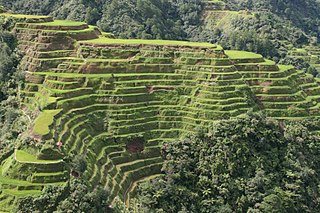
The Banaue Rice Terraces are terraces that were carved into the mountains of Banaue, Ifugao, in the Philippines, by the ancestors of the Igorot people. The terraces are occasionally called the "Eighth Wonder of the World". It is commonly thought that the terraces were built with minimal equipment, largely by hand. The terraces are located approximately 1,500 meters above sea level. These are fed by an ancient irrigation system from the rainforests above the terraces. It is said that if the steps were put end to end, it would encircle half of the globe.

Indigenous Philippine folk religions are the distinct native religions of various ethnic groups in the Philippines, where most follow belief systems in line with animism. Generally, these Indigenous folk religions are referred to as Anito or Anitism or the more modern and less ethnocentric Dayawism, where a set of local worship traditions are devoted to the anito or diwata, terms which translate to Gods, spirits, and ancestors. Many of the narratives within the indigenous folk religions are orally transmitted to the next generation, but many have traditionally been written down as well. The Spanish have claimed that the natives did not have religious writings.

The Rice Terraces of the Philippine Cordilleras are a World Heritage Site consisting of a complex of rice terraces on the island of Luzon in the Philippines. They were inscribed on the UNESCO World Heritage List in 1995, the first-ever property to be included in the cultural landscape category of the World Heritage List. This inscription has five sites: the Batad Rice Terraces and Bangaan Rice Terraces, Mayoyao Rice Terraces, Hungduan Rice Terraces and Nagacadan Rice Terraces, all in Ifugao Province. The Ifugao Rice Terraces reach a higher altitude and were built on steeper slopes than many other terraces. The Ifugao complex of stone or mud walls and the careful carving of the natural contours of hills and mountains combine to make terraced pond fields, coupled with the development of intricate irrigation systems, harvesting water from the forests of the mountain tops, and an elaborate farming system.

The Tagbanwa people are an indigenous peoples and one of the oldest ethnic groups in the Philippines, mainly found in central and northern Palawan. Research has shown that the Tagbanwa are possible descendants of the Tabon Man, thus making them one of the original inhabitants of the Philippines. They are a brown-skinned, slim, and straight-haired ethnic group.

The Beembe are a Bantu people living in southern Congo-Brazzaville, precisely in Bouenza and in the cities of Brazzaville, Dolisie, and Pointe-Noire. It is a Kongo subgroup. The Beembe have some similar customs to the Kongo, which is what makes them a subgroup, but their art is what separates them apart. It is not clear when the Beembe separated from the Kongo but oral tradition suggests that it was some time around the eight century. They migrated Northeast from the Kongo and settled some five hundred kilometers from the capital of the Kingdom of the Kongo. This group was a part of the Kongo Kingdom during its height of power. The Beembe also have subgroups within it such as the Bisi-Nseke, Minkegue, Mmsumbu (Bambumbu), the Mongo, and the Musitu.Beembe society is economically based on agriculture.
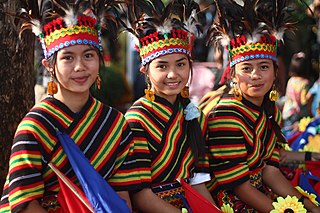
The Ifugao people are the ethnic group inhabiting Ifugao province in the Philippines. They reside in the municipalities of Lagawe, Aguinaldo, Alfonso Lista, Asipulo, Banaue, Hingyon, Hungduan, Kiangan, Lamut, Mayoyao, and Tinoc. The province is one of the smallest provinces in the Philippines with an area of only 251,778 hectares, or about 0.8% of the total Philippine land area. As of 1995, the population of the Ifugaos was counted to be 131,635. Although the majority of them are still in Ifugao province, some of them have moved to Baguio, where they work as woodcarvers, and to other parts of the Cordillera Region.
The arts in the Philippines reflect a range of artistic influences on the country's culture, including indigenous art. Philippine art consists of two branches: traditional and non-traditional art. Each branch is divided into categories and subcategories.

Kulap figurines of limestone or chalk were made in Melanesia. The small funerary sculptures from New Ireland were associated with death rituals. They are typical in the hilly Punam region of the New Ireland province in Papua New Guinea of the Bismarck Archipelago. They were believed to contain the soul of the deceased person whom they were meant to represent, and would be ritually smashed once their usefulness or the period of mourning was over. In more recent years, some have been sold in their intact forms to Westerners, particularly to German administrators.

The pasiking is the indigenous basket-backpack found among the various ethno-linguistic groups of Northern Luzon in the Philippines. Pasiking designs have sacred allusions, although most are purely aesthetic. These artifacts, whether handwoven traditionally or with contemporary variations, are considered exemplars of functional basketry in the Philippines and among Filipinos.

Tapuy, also spelled tapuey or tapey, is a rice wine produced in the Philippines. It is a traditional beverage originated from Banaue and Mountain Province, where it is used for important occasions such as weddings, rice harvesting ceremonies, fiestas and cultural fairs. It is produced from either pure glutinous rice or a combination of glutinous and non-glutinous rice together with onuad roots, ginger extract, and a powdered starter culture locally known as bubod. Tapuy is an Ilocano name. The wine is more commonly called baya or bayah in Igorot languages.
The Mbole people are an ethnic group of about 150,000 people living in the Orientale Province, southwest of Kisangani in the Democratic Republic of the Congo. The Mbole were previously referred to as Bambole.

The Kankanaey people are an indigenous peoples of northern Luzon, Philippines. They are part of the collective group of indigenous peoples in the Cordillera known as the Igorot people.

Nias people are an ethnic group native to Nias, an island off the west coast of North Sumatra, Indonesia. In the Nias language, the Nias people are known as Ono Niha, which means 'descendants of humans'. Nias island is known as Tanö Niha, with Tanö meaning 'land' in the Nias language.

Anito, also spelled anitu, refers to ancestor spirits, nature spirits, and deities in the Indigenous Philippine folk religions from the precolonial age to the present, although the term itself may have other meanings and associations depending on the Filipino ethnic group. It can also refer to carved humanoid figures, the taotao, made of wood, stone, or ivory, that represent these spirits. Anito is also sometimes known as diwata in certain ethnic groups.
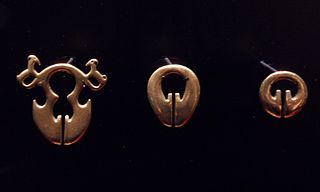
Lingling-o or ling-ling-o are a type of penannular or double-headed pendant or amulet that have been associated with various late Neolithic to late Iron Age Austronesian cultures. Most lingling-o were made in jade workshops in the Philippines, and to a lesser extent in the Sa Huỳnh culture of Vietnam, although the raw jade was mostly sourced from Taiwan.
Binakle is a type of steamed rice cake originating from the Ifugao province of the Philippines. It is made from glutinous rice (diket) that is pounded into a paste, wrapped in banana or rattan leaves, and steamed. Variants may also add sesame seeds or sweet potato. They are popularly eaten on special occasions or as a snack. Uncooked binakle, along with rice wine (baya), are common offerings to the bulul ancestor spirits in Ifugao rituals.

